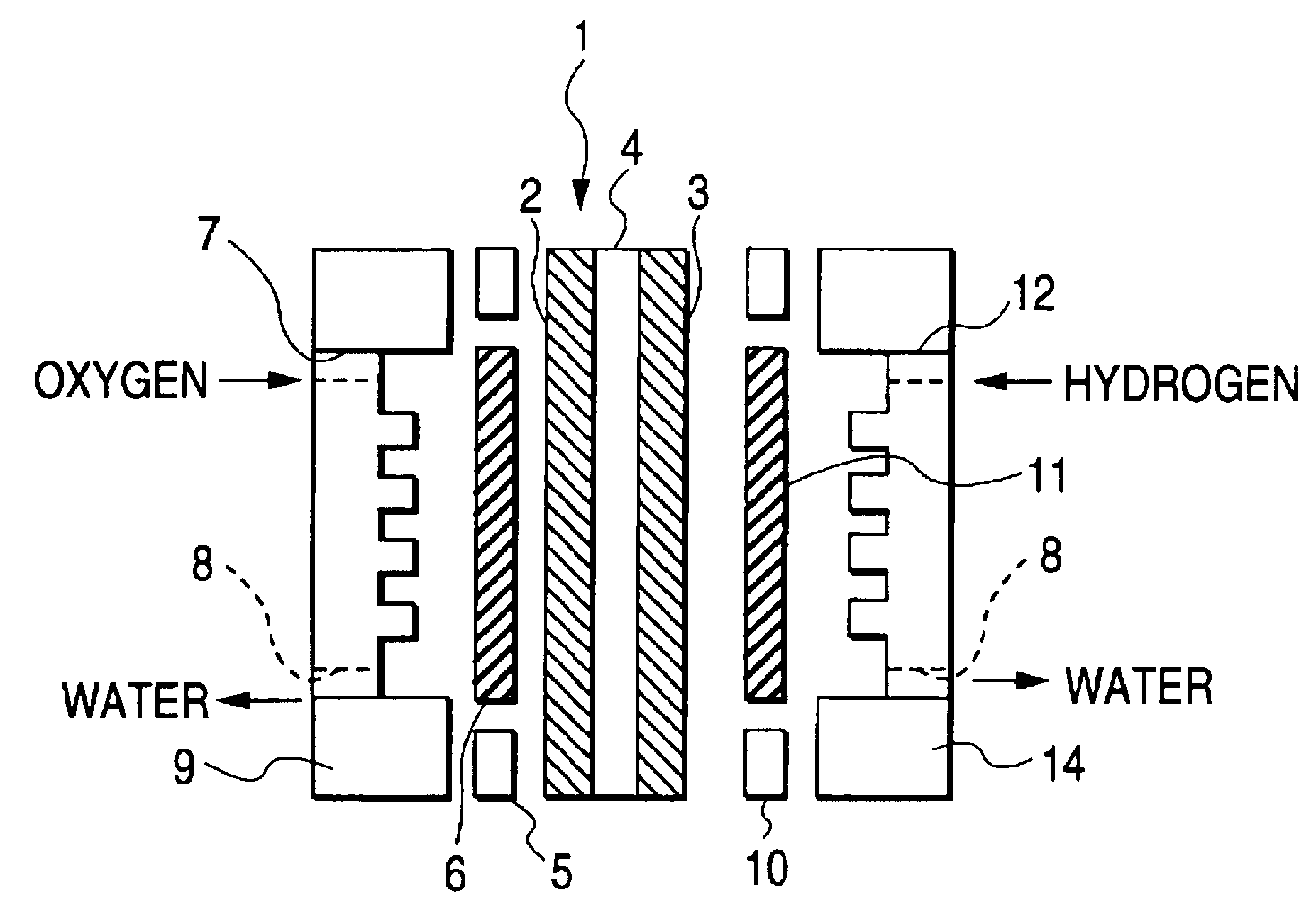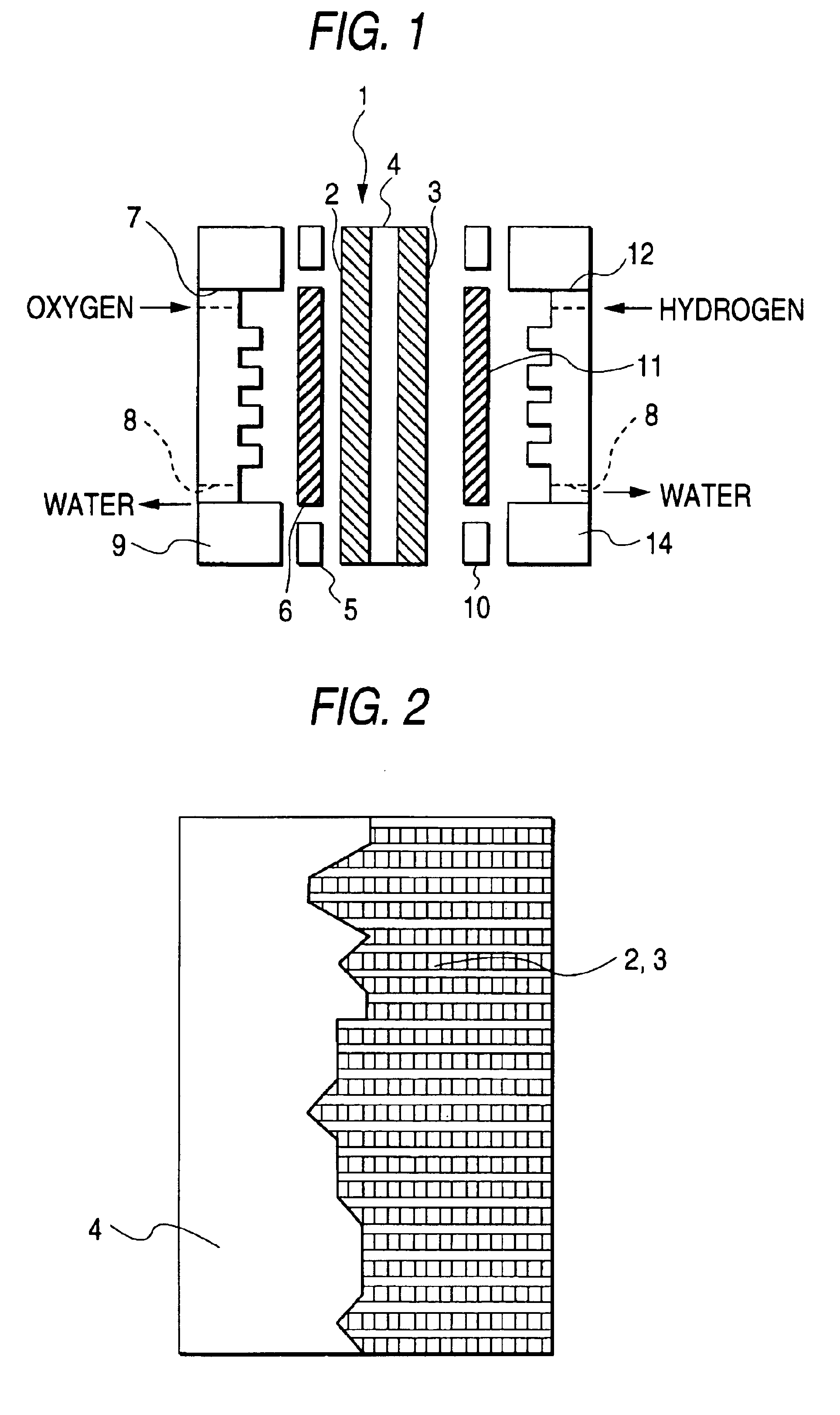Electrode-membrane assembly and process for the preparation thereof
- Summary
- Abstract
- Description
- Claims
- Application Information
AI Technical Summary
Benefits of technology
Problems solved by technology
Method used
Image
Examples
example 1
In an autoclave, a perfluorovinyl ether [CF2═CF—(OCF2CFCF3)—O—(CF2)2SO2F] monomer having a protected functional group was dissolved in 1,1,2-trichloro-1,2,2-trifluoroethane as a diluent to make a 40 wt % solution. To the solution was then added a radical reaction initiator. While TFE gas was pressed into the autoclave at a pressure of 2 kgf / cm2, the reaction solution was then heated to a temperature of 40° C. so that the monomer and TFE gas were allowed to polymerization to obtain a copolymer.
The copolymer thus obtained exhibited an exchange capacity of 1.4 milliequivalents / g of dried resin. The resin powder thus produced was then formed over a 280° C. hot roller into a sheet having a thickness as small as about 0.05 mm to obtain a precursor (thermoplastic resin) of solid polymer electrolyte.
Subsequently, an iridium oxide catalyst powder was dissolved in an alcohol solvent having a fluororesin suspended therein to prepare a paste. The paste thus prepared was fixed to a (porous) sint...
example 2
A particulate furnace black carbon having platinum (which acts as an oxygen reduction electrode) supported thereon and a particulate furnace black carbon having a platinum-ruthenium alloy (which acts as a hydrogen oxidation electrode) supported thereon were used as an electrode material. The two electrode materials were each mixed with a fluororesin and naphtha. The mixtures were each washed with acetone, dried, and then calcined on a porous substrate made of carbon fiber at a temperature of 130° C. to prepare a cathode and an anode each having a catalyst supported thereon in an amount of 100 g / m2, respectively.
The polymer solid electrolyte precursor obtained in Example 1 was disposed interposed between the two electrodes. The assembly thus obtained was then heated to a temperature of 280° C. under a low pressure to obtain a homogeneous assembly having a finished polymer solid electrolyte thickness of about 30 μm. In this manner, at least a part of the precursor resin component was ...
example 3
A copolymer was prepared in the same manner as in Example 1 except that the reaction solution was heated to a temperature of 45° C. while TEF gas was pressed into the autoclave at a pressure of 4 kgf / cm2.
The copolymer thus obtained exhibited an exchange capacity of 1.2 milliequivalents / g of dried resin. The resin powder thus produced was then formed over a 280° C. hot roller into a sheet having a thickness as small as about 0.01 mm to obtain a precursor (thermoplastic resin) of solid polymer electrolyte.
The polymer solid electrolyte precursor thus obtained was processed in the same manner as in Example 2, and then assembled to a fuel cell. Using this fuel, the relationship between voltage and current was then measured. As a result, the cell voltage was 0.75 V at a current of 20 A.
PUM
| Property | Measurement | Unit |
|---|---|---|
| Mechanical strength | aaaaa | aaaaa |
Abstract
Description
Claims
Application Information
 Login to View More
Login to View More - R&D
- Intellectual Property
- Life Sciences
- Materials
- Tech Scout
- Unparalleled Data Quality
- Higher Quality Content
- 60% Fewer Hallucinations
Browse by: Latest US Patents, China's latest patents, Technical Efficacy Thesaurus, Application Domain, Technology Topic, Popular Technical Reports.
© 2025 PatSnap. All rights reserved.Legal|Privacy policy|Modern Slavery Act Transparency Statement|Sitemap|About US| Contact US: help@patsnap.com


